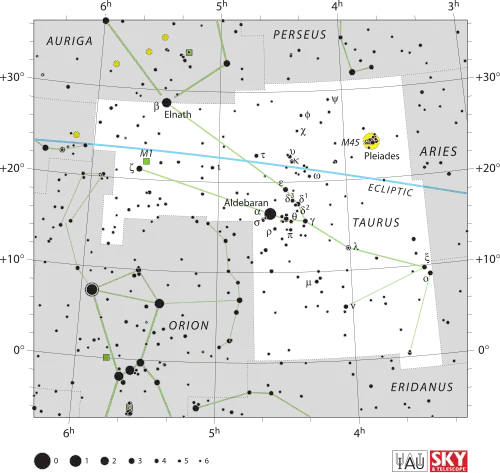Sigma1 Tauri
| Observation data Epoch J2000.0 Equinox J2000.0 (ICRS) | |
|---|---|
| Constellation | Taurus |
| Right ascension | 04h 39m 09.22247s[1] |
| Declination | +15° 47′ 59.5345″[1] |
| Apparent magnitude (V) | 5.07[2] |
| Characteristics | |
| Spectral type | A4m[3] |
| U−B color index | 0.190[2] |
| B−V color index | 0.146[2] |
| Astrometry | |
| Radial velocity (Rv) | +26.1±10.0[4] km/s |
| Proper motion (μ) | RA: +41.91[1] mas/yr Dec.: −66.88[1] mas/yr |
| Parallax (π) | 22.18±0.93 mas[1] |
| Distance | 147 ± 6 ly (45 ± 2 pc) |
| Absolute magnitude (MV) | 1.73[2] |
| Orbit[5] | |
| Primary | σ1 Tau A |
| Companion | σ1 Tau B |
| Period (P) | 38.951 d |
| Eccentricity (e) | 0.15 |
| Longitude of the node (Ω) | 82° |
| Periastron epoch (T) | 2443094.319 JD |
| Semi-amplitude (K1) (primary) | 7.9 km/s |
| Details | |
| Mass | 1.94[2] M☉ |
| Luminosity | 14.7[6] L☉ |
| Surface gravity (log g) | 4.08[2] cgs |
| Temperature | 8,470[2] K |
| Rotational velocity (v sin i) | 56.5±7.1[7] km/s |
| Other designations | |
| 91 Tauri, BD+15°665, HD 29479, HIP 21673, HR 1478, SAO 94051, WDS J04393+1555B[8] | |
| Database references | |
| SIMBAD | data |
Sigma1 Tauri (σ1 Tauri) is the Bayer designation for a white-hued star in the zodiac constellation of Taurus. It has an apparent visual magnitude of +5.07,[2] which indicates it is visible to the naked eye. Based upon parallax measurements, σ1 Tauri is about 147 light-years from the Sun.
σ1 Tauri is a single-lined spectroscopic binary star system with an orbital period of 38.951 days and an eccentricity of 0.15. The visible component is an Am star with a stellar classification of A4m,[3] indicating it is chemically peculiar A-type star. It is spinning with a projected rotational velocity of 56.5 km/s.[7] The star has 1.9[2] times the mass of the Sun and is radiating 14.7[6] times the Sun's luminosity from its photosphere at an effective temperature of 8,470 K.[2] Although it lies in the general direction of the Hyades cluster, based on parallax measurements it has been excluded from the list of candidate members.[2]
References
- ^ a b c d e van Leeuwen, F. (2007), "Validation of the new Hipparcos reduction", Astronomy and Astrophysics, 474 (2): 653–664, arXiv:0708.1752, Bibcode:2007A&A...474..653V, doi:10.1051/0004-6361:20078357, S2CID 18759600.
- ^ a b c d e f g h i j k Iliev, I. Kh.; et al. (August 2006), "Abundance analysis of Am binaries and search for tidally driven abundance anomalies - II. HD861, HD18778, HD20320, HD29479, HD96528 and HD108651", Monthly Notices of the Royal Astronomical Society, 370 (2): 819–827, Bibcode:2006MNRAS.370..819I, doi:10.1111/j.1365-2966.2006.10513.x, S2CID 56133360.
- ^ a b Cowley, A.; et al. (1969), "A study of the bright A stars. I. A catalogue of spectral classifications", Astronomical Journal, 74: 375–406, Bibcode:1969AJ.....74..375C, doi:10.1086/110819.
- ^ de Bruijne, J. H. J.; Eilers, A.-C. (October 2012), "Radial velocities for the HIPPARCOS-Gaia Hundred-Thousand-Proper-Motion project", Astronomy & Astrophysics, 546: 14, arXiv:1208.3048, Bibcode:2012A&A...546A..61D, doi:10.1051/0004-6361/201219219, S2CID 59451347, A61.
- ^ Pourbaix, D.; et al. (2004), "SB9: The ninth catalogue of spectroscopic binary orbits", Astronomy and Astrophysics, 424 (2): 727–732, arXiv:astro-ph/0406573, Bibcode:2004A&A...424..727P, doi:10.1051/0004-6361:20041213, S2CID 119387088.
- ^ a b McDonald, I.; et al. (2012), "Fundamental Parameters and Infrared Excesses of Hipparcos Stars", Monthly Notices of the Royal Astronomical Society, 427 (1): 343–57, arXiv:1208.2037, Bibcode:2012MNRAS.427..343M, doi:10.1111/j.1365-2966.2012.21873.x, S2CID 118665352.
- ^ a b Paunzen, E.; et al. (February 2013), "A photometric study of chemically peculiar stars with the STEREO satellites - II. Non-magnetic chemically peculiar stars", Monthly Notices of the Royal Astronomical Society, 429 (1): 119–125, arXiv:1211.1535, Bibcode:2013MNRAS.429..119P, doi:10.1093/mnras/sts318, S2CID 119231581.
- ^ "sig01 Tau". SIMBAD. Centre de données astronomiques de Strasbourg. Retrieved 2017-08-06.
{{cite web}}: CS1 maint: postscript (link)
